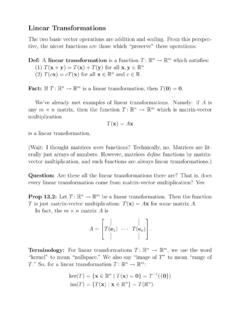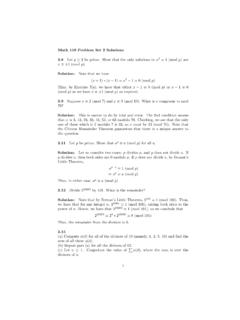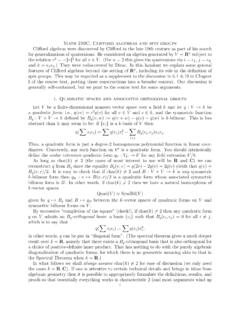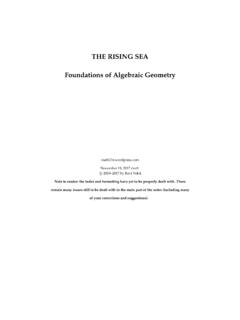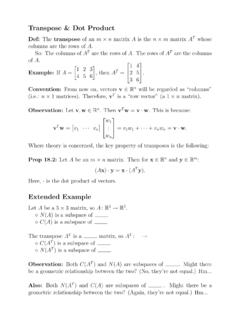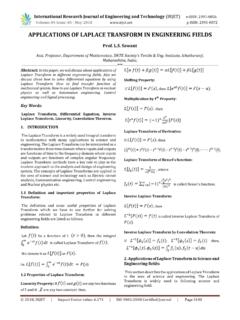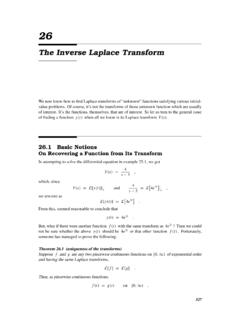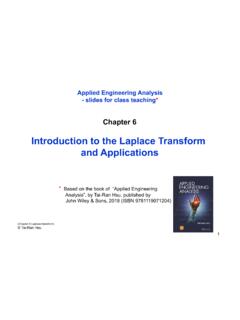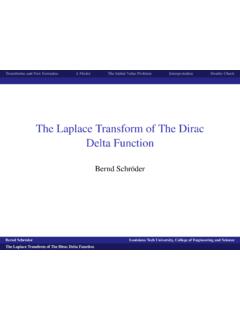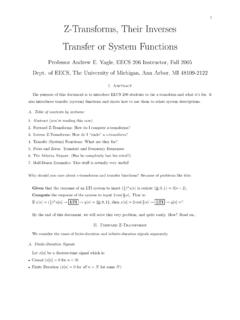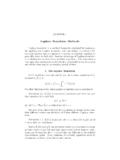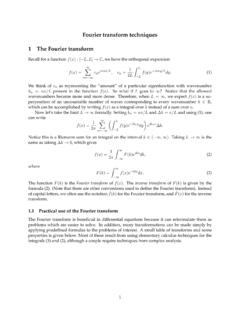Transcription of Laplace Transform: Examples - Stanford University
1 Laplace transform : ExamplesDef:Given a functionf(t) defined fort >0. ItsLaplace transformis thefunction, denotedF(s) =L{f}(s), defined by:F(s) =L{f}(s) = 0e stf(t)dt.(Issue:The Laplace transform is an improper integral. So, does it always exist? : Is thefunctionF(s) always finite?Answer:This is a little subtle. We ll discuss this next time.)Fact (Linearity):The Laplace transform islinear:L{c1f1(t) +c2f2(t)}=c1L{f1(t)}+c2L{f2(t)}.Example 1:L{1}=1sExample 2:L{eat}=1s aExample 3:L{sin(at)}=as2+a2 Example 4:L{cos(at)}=ss2+a2 Example 5:L{tn}=n!
2 Sn+1 Useful Fact:Euler s Formula says thateit= cost+isinte it= cost isintTherefore,cost=12(eit+e it),sint=12i(eit e it). Laplace transform : Key PropertiesRecall:Given a functionf(t) defined fort >0. ItsLaplace transformisthe function, denotedF(s) =L{f}(s), defined by:F(s) =L{f}(s) = 0e stf(t) :In the following, letF(s) =L{f(t)}.Fact A:We haveL{eatf(t)}=F(s a).Fact B (Magic):Derivatives int Multiplication bys(well, almost).L{f (t)}=(s1) (F(s) f(0))=sF(s) f(0)L{f (t)}= s2s1 F(s) f(0) f (0) =s2F(s) sf(0) f (0)L{f(n)(t)}= snsn F(s) f(0) f(n 2)(0) f(n 1)(0) =snF(s) sn 1f(0) sf(n 2)(0) f(n 1)(0).
3 Fact C (Magic):Multiplication byt Derivatives ins(almost).L{tf(t)}= F (s)L{tnf(t)}= ( 1)nF(n)(s). Laplace transform : ExistenceRecall:Given a functionf(t) defined fort >0. ItsLaplace transformisthe function defined by:F(s) =L{f}(s) = 0e stf(t) :The Laplace transform is an improper integral. So, does it alwaysexist? : Is the functionF(s) always finite?Def:A functionf(t) is ofexponential orderif there is a thresholdM 0and constantsK >0,a Rsuch that|f(t)| Keat,whent : There is a thresholdM 0 and a constanta Rsuch thatthe functionf(t)eatisboundedwhent M(meaning that f(t)eat K).
4 Theorem:Letf(t) be a function that is:(1) continuous;(2) of exponential order (with exponenta).Then:(a)F(s) =L{f(t)}(s) exists for alls > a; and(b) lims F(s) = :The functionf(t) = exp(t2) is not of exponential :Iff(t) is not continuous, or not of exponential order, then theLaplace transform may or may not Laplace transform : ExistenceWant:A notion of inverse Laplace transform . That is, we would like tosay that ifF(s) =L{f(t)}, thenf(t) =L 1{F(s)}.Issue:How do we know thatLeven has an inverseL 1?
5 Remember, not alloperations have see the problem: imagine that there are different functionsf(t) andg(t) which have the same Laplace transformH(s) =L{f}=L{g}. ThenL 1{H(s)}would make no sense: after all, shouldL 1{H}bef(t) org(t)?Fortunately, this bad scenario can never happen:Theorem:Letf(t),g(t) be continuous functions on [0, ) of exponentialorder. IfL{f}=L{g}, thenf(t) =g(t) for allt [0, ).Def:Letf(t) be continuous on [0, ) and of exponential callf(t) theinverse Laplace transformofF(s) =L{f(t)}.]]]
6 Wewritef=L 1{F}.Fact (Linearity):The inverse Laplace transform islinear:L 1{c1F1(s) +c2F2(s)}=c1L 1{F1(s)}+c2L 1{F2(s)}.Inverse Laplace transform : ExamplesExample 1:L 1{1s a}=eatExample 2:L 1{1(s a)n}=eattn 1(n 1)!Example 3:L 1{ss2+b2}= cosbtExample 4:L 1{1s2+b2}=1bsinbtFact A:We haveL{eatf(t)}=F(s a).Therefore:L 1{F(s a)}=eatL 1{F(s)}.Partial FractionsSetup:Given a rational functionR(x) =p(x)q(x).Saying thatRis rational means that bothpandqare by factoring the denominatorq(x) overR. (The phrase overR means, , thatx3+ 4xfactors asx(x2+ 4).)
7 That is, we do not allow com-plex numbers. Factoring intox(x+ 2i)(x 2i) would be factoring overC. )Case 1:q(x) has linear distinct factors, meaning that we can expressq(x) =(x a1) (x an). In this case, we writep(x)q(x)=A1x a1+ +Anx 2:q(x) has linear factors, where some are repeated. Corresponding tothis factor like (x a)p, we writeA1x a+A2(x a)2+ +Ap(x a) 3:q(x) has a quadratic factor, not repeated. Corresponding to a factorlike (x ( +i ))(x ( i )) = (x )2+ 2, we writeA(x ) +B (x )2+ 4:q(x) has repeated quadratic factors.
8 Corresponding to a factor like((x )2+ 2)n, we writeA1(x ) +B1 (x )2+ 2+A2(x ) +B2 ((x )2+ 2)2+ +An(x ) +Bn ((x )2+ 2) :Here is a partial fraction decomposition:7x3+ 2(x 3)2(x2+ 25)2=Ax 3+B(x 3)2+Cx+ 5Dx2+ 25+Ex+ 5F(x2+ 25) : Intro to Power SeriesApower seriesis a series of the form n=0an(x x0)n=a0+a1(x x0) +a2(x x0)2+ It can be thought of as an infinite polynomial. The numberx0is called power series may converge for some values ofx, but diverge for othervalues ofx. A power series willalwaysconverge at its centerx=x0(do yousee why?)
9 Question:Given a power series, for what values ofxdoes it converge, andfor what values ofxdoes it diverge?Theorem:Given a power series an(x x0)n. Then either:(i) The power series converges only atx=x0. (CaseR= 0)(ii) The power series converges for allx R. (CaseR= + )(iii) The power series converges on an interval|x x0|< R, and divergesif|x x0|> numberRis called theradius of :This theorem says nothing about the convergence/divergence at theendpoints of the interval. Those have to be checked the Interval of Convergence:(1) Determine the centerx0.
10 (2) Determine the radius of convergenceR. Use the Ratio Test to do this.(3) Check convergence/divergence at the : Power Series are FunctionsGiven a power series an(x x0)n, we can think of it as a function ofx:f(x) = n=0an(x x0) off(x): The set of allx-values for which the series converges. Thatis, the domain is exactly the interval of every power series (withR >0) is a function, not all functionsarise in this way. : Not all functions are equal to a convergent powerseries! Those functions which are have a special name:Def:A functionf(x) isanalyticatx=x0if it is equal to a power seriesf(x) = n=0an(x x0)nthat haspositiveradius of convergenceR > functions are the best-behaved functions in all of calculus.
